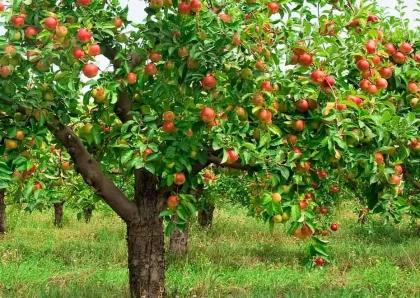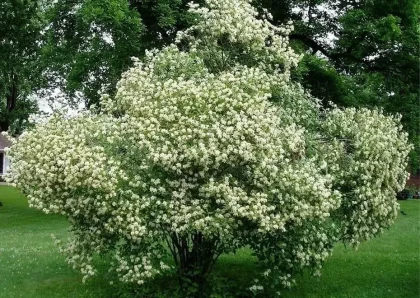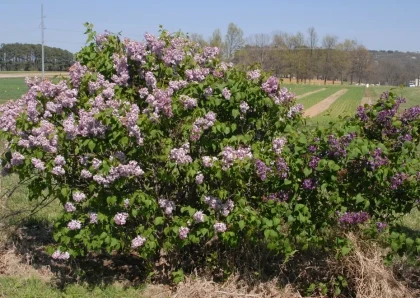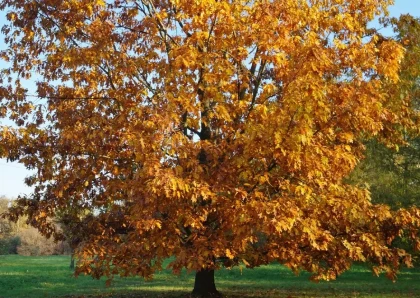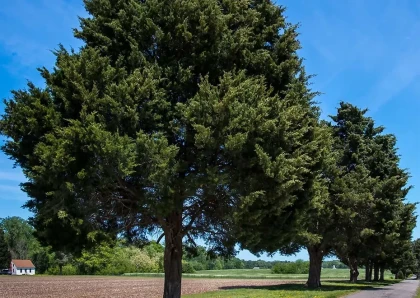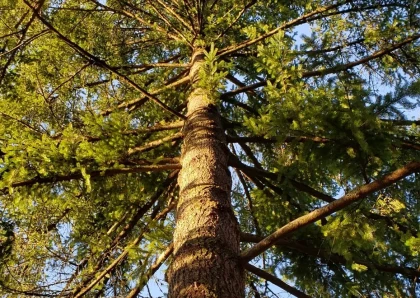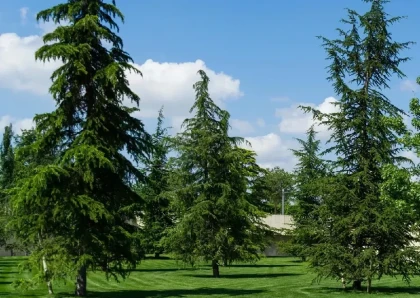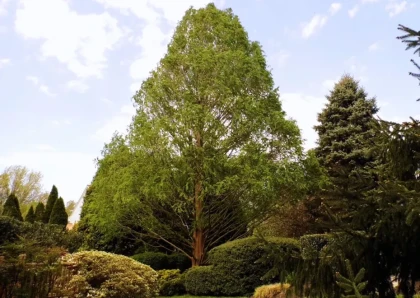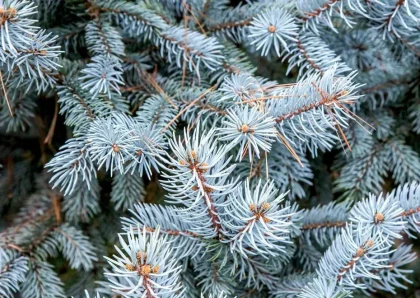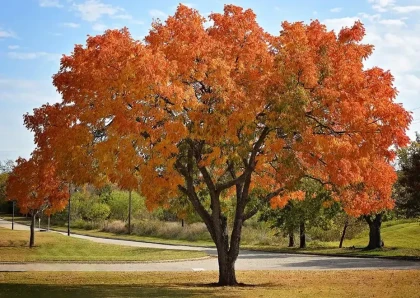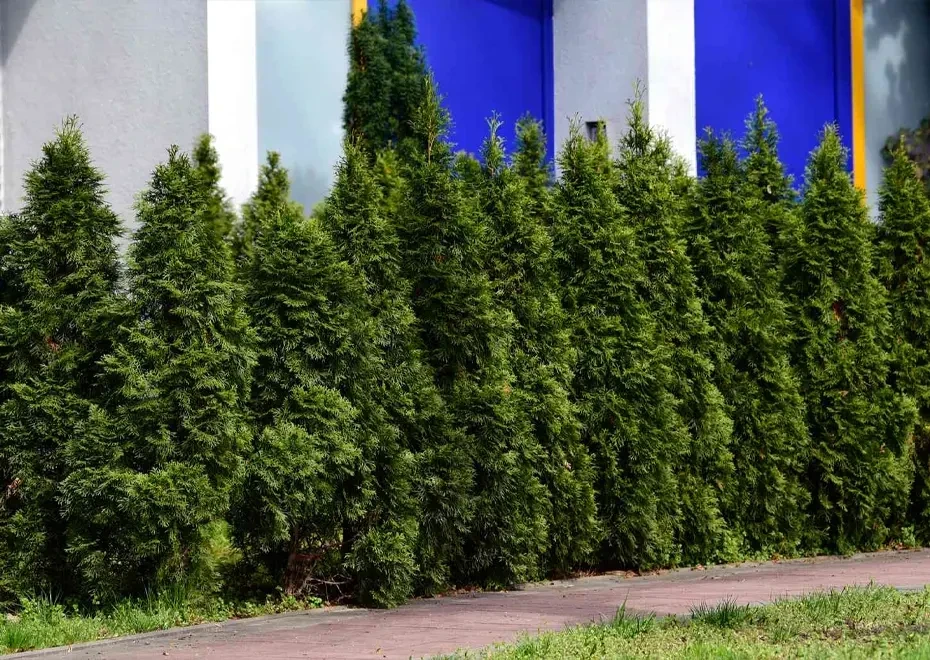
Emerald Arborvitae Tree
Overview
The Emerald Arborvitae (Thuja occidentalis 'Smaragd') is a popular evergreen tree or shrub in landscaping and gardening. It belongs to the cypress family (Cupressaceae) and is commonly known as the "Emerald Green" or "Smaragd" arborvitae.
Here are some key features of the Emerald Arborvitae:
- Appearance: The Emerald Arborvitae is a compact, dense, and narrow conifer with a pyramidal shape. It typically maintains a rich green color throughout the year, even in colder climates. The foliage consists of small, scale-like leaves arranged in flattened sprays.
- Size: This tree usually grows to a moderate height, ranging from 10 to 15 feet (3 to 4.5 meters) tall, with a spread of about 3 to 4 feet (0.9 to 1.2 meters).
- Growth Rate: The Emerald Arborvitae is considered a slow to medium-growing tree. It won't shoot up quickly like some other trees, making it ideal for smaller spaces and landscapes.
- Landscape Use: Due to its slender form and dense foliage, the Emerald Arborvitae is often used for hedges, screens, and privacy borders. It can also be planted individually as an accent plant or specimen in landscapes or gardens.
- Hardiness: It is well-adapted to various climates and is generally hardy in USDA hardiness zones 2 to 7.
- Care: The Emerald Arborvitae prefers well-draining soil and should be planted in a location that receives full to partial sun. Once established, it generally requires minimal maintenance, such as regular watering during dry spells and occasional pruning to maintain its shape.
Different Type of Emerald Arborvitae Cultivars
- Thuja occidentalis 'Smaragd' or 'Emerald Green': This is the original and most common cultivar, known for its compact, pyramidal shape and rich green foliage.
- Thuja occidentalis 'Smaragd' (North American strain): This strain is similar to the original 'Smaragd' but may exhibit slight differences in growth rate and form.
- Thuja occidentalis 'Smaragd' (European strain): This strain is also similar to the original 'Smaragd' but may have slightly different growth habits and foliage characteristics.
- Thuja occidentalis 'Smaragd' (Danish strain): This strain is known for its narrower and more columnar growth form compared to the original 'Smaragd'.
- Thuja occidentalis 'Golden Smaragd' or 'Golden Emerald': This cultivar features golden-yellow foliage, adding a touch of vibrant color to the landscape.
- Thuja occidentalis 'Hetz Wintergreen': This cultivar is known for its winter hardiness and ability to retain its green color throughout colder months.
- Thuja occidentalis 'Hetz Midget': This is a dwarf cultivar with a slow growth rate, making it suitable for smaller spaces or container planting.
- Thuja occidentalis 'Rheingold': This cultivar has foliage that starts as golden-yellow in the spring and transitions to a rich bronze hue in the winter.
- Thuja occidentalis 'Woodwardii': This cultivar has a broader, more open growth habit compared to the typical 'Smaragd' arborvitae.
Potential wood products that could be made from Emerald Arborvitae
- Furniture: If Arborvitae trees are large enough and suitable for woodworking, the wood could potentially be used to make small-scale furniture, such as cabinets, shelves, or decorative items.
- Crafts and Woodworking: Arborvitae wood might be suitable for various crafting and woodworking projects, such as small sculptures, carvings, or turning into wooden bowls and pens.
- Interior Finishings: In some cases, the wood might be used for interior finishings in home construction, such as trim, paneling, or molding.
- Fragrance and Aromatic Products: Arborvitae wood contains aromatic oils, which could be used in the production of fragrances, essential oils, or aromatic products.
Benefits of Emerald Arborvitae:
- Privacy Screening: One of the primary benefits of Emerald Arborvitae is its dense and compact growth habit, making it an excellent choice for creating privacy screens and hedges. When planted closely together, the trees create a natural barrier that can block out unwanted views and reduce noise.
- Attractive Appearance: The Emerald Arborvitae's rich green foliage and pyramidal shape add visual appeal to any landscape. Its neat and uniform appearance makes it an excellent choice for creating formal gardens and adding structure to outdoor spaces.
- Year-Round Greenery: As an evergreen tree, Emerald Arborvitae retains its vibrant green color throughout the year. This feature ensures that your landscape remains attractive, even during the winter months when many other plants lose their leaves.
- Low Maintenance: Once established, Emerald Arborvitae is relatively low maintenance. It is drought-tolerant and requires minimal pruning to maintain its shape. Regular watering during dry periods and occasional fertilization can promote healthy growth.
- Adaptability: Emerald Arborvitae is adaptable to various soil types and growing conditions. It can thrive in both full sun and partial shade, making it a versatile choice for a wide range of landscapes.
- Versatility in Landscaping: Due to its narrow and compact form, Emerald Arborvitae can be used in various landscaping settings. It works well as a focal point, accent plant, or specimen tree. Additionally, it can be planted along property lines, driveways, or walkways to define borders and add structure.
- Cold Hardiness: Emerald Arborvitae is generally hardy and can withstand colder climates, making it suitable for use in northern regions.
- Wildlife Attraction: The dense foliage of Emerald Arborvitae provides shelter and nesting opportunities for various birds and small animals, contributing to the overall biodiversity of your garden.
- Natural Aromatics: Some Arborvitae varieties, including 'Smaragd', emit a pleasant fragrance when their leaves are crushed or brushed, adding an aromatic aspect to the landscape.
- Air Quality Improvement: Like other trees, Emerald Arborvitae contributes to air quality improvement by absorbing carbon dioxide and releasing oxygen during photosynthesis.
Tips for planting and maintaining Emerald Arborvitae Tree
Tips for Planting Emerald Arborvitae:- Location: Choose a planting location that receives full to partial sun. Emerald Arborvitae can tolerate a range of soil types but prefers well-draining soil.
- Spacing: When planting multiple Arborvitae, provide adequate spacing between each tree to allow for proper growth and airflow. Follow the specific spacing recommendations for the mature size of the cultivar you have.
- Digging the Hole: Dig a hole that is slightly wider than the root ball and of sufficient depth to accommodate the root system. The top of the root ball should be level with the ground.
- Amending the Soil: Mix some organic matter, like compost, with the native soil to enhance its fertility and drainage. Avoid planting Arborvitae in heavy, waterlogged soils.
- Watering: Water the tree thoroughly at the time of planting and keep the soil consistently moist for the first year to aid in root establishment.
- Mulching: Apply a layer of organic mulch, such as wood chips or bark, around the base of the tree. Mulch helps retain soil moisture, regulate temperature, and prevent weed growth.
- Watering: While Arborvitae is relatively drought-tolerant once established, regular watering is crucial during dry periods, especially in the first year after planting. Water deeply but infrequently to encourage deep root growth.
- Pruning: Minimal pruning is usually required for Emerald Arborvitae. However, you can lightly trim and shape the tree in early spring to maintain its desired form and remove any dead or damaged branches.
- Fertilization: Emerald Arborvitae generally does not require frequent fertilization. If you notice signs of nutrient deficiency, you can apply a balanced, slow-release fertilizer in spring.
- Protect from Winter Damage: In regions with harsh winters, consider wrapping the tree in burlap or using an anti-desiccant spray to protect the foliage from winter winds and potential drying.
- Pest and Disease Monitoring: Keep an eye out for common pests like bagworms or spider mites and promptly address any infestations. Additionally, monitor the tree for signs of disease, such as needle browning or cankers, and take appropriate action if necessary.
- Avoid Overwatering: While it's essential to keep the soil moist, avoid overwatering, as this can lead to root rot or other issues.
- Avoid Excessive Mulching: Ensure that the mulch is not piled up against the trunk of the tree, as this can lead to moisture retention and potential issues with the bark.
Cons of Planting Emerald Arborvitae:
- Susceptibility to Certain Pests: Emerald Arborvitae can be susceptible to pests such as bagworms, spider mites, and aphids. If left unchecked, these pests can cause damage to the foliage and affect the tree's health.
- Vulnerability to Certain Diseases: Some Arborvitae varieties, including Emerald Arborvitae, can be vulnerable to diseases such as root rot and various fungal infections. These diseases can lead to browning of the foliage, branch dieback, and overall decline of the tree.
- Not Suitable for Hot and Dry Climates: While Emerald Arborvitae is generally hardy in various climates, it may not thrive in extremely hot and dry conditions. Prolonged periods of heat and drought can stress the tree and lead to issues with its health.
- Potential Winter Burn: In regions with harsh winters, the foliage of Emerald Arborvitae can be susceptible to winter burn, which is caused by exposure to cold winds and freezing temperatures. Winter burn can result in browning or discoloration of the foliage.
- Limited Lifespan: Like many ornamental trees, Emerald Arborvitae has a finite lifespan. Depending on the specific growing conditions and maintenance, its lifespan may be limited compared to some other tree species.
- Slow Growth Rate: While the slow growth rate of Emerald Arborvitae can be an advantage for smaller spaces, it may also be a disadvantage if you desire rapid growth or quick screening for privacy purposes.
- Potential Size Constraints: Some Arborvitae varieties, including Emerald Arborvitae, have a limited mature size, which may not be suitable for larger landscaping projects or areas requiring taller trees.
- Possible Invasive Traits: While Emerald Arborvitae itself is not considered invasive, it's essential to be cautious about planting non-native Arborvitae varieties in some regions, as they may potentially escape cultivation and become invasive.
- Need for Regular Maintenance: Though Emerald Arborvitae is relatively low-maintenance, it still requires periodic care, such as watering during dry periods, pruning to maintain its shape, and pest and disease monitoring.
- Relatively Common in Landscaping: Emerald Arborvitae is a widely planted and popular landscaping tree, which means it might lack uniqueness in some settings or be subject to potential overuse in certain areas.
Conclusion
Emerald Arborvitae (Thuja occidentalis 'Smaragd') is a versatile and attractive evergreen tree that offers numerous benefits in landscaping and gardening projects. Its dense and compact growth habit makes it an excellent choice for privacy screening, hedges, and borders. The year-round greenery and pyramidal shape add visual appeal to any landscape, and its adaptability to various soil types and climates make it suitable for a wide range of environments.
While planting Emerald Arborvitae can bring beauty and functionality to your outdoor space, it is essential to be aware of some potential cons. These include susceptibility to certain pests and diseases, vulnerability to winter burn in harsh climates, and the need for regular maintenance to ensure its health and longevity. Additionally, in regions with extremely hot and dry conditions, careful consideration of the tree's water needs is necessary.
Overall, with proper care and attention, Emerald Arborvitae can thrive and provide long-lasting beauty and privacy to your garden or landscape. Its evergreen nature, low-maintenance requirements, and versatility in various settings make it a popular choice for both residential and commercial projects. By understanding its specific growing conditions and considering the pros and cons, you can make an informed decision about incorporating Emerald Arborvitae into your outdoor space and enjoy its many benefits for years to come.
FAQs
1. What is Emerald Arborvitae?
Emerald Arborvitae (Thuja occidentalis 'Smaragd') is a popular evergreen tree or shrub in landscaping and gardening. It belongs to the cypress family (Cupressaceae) and is commonly known as the "Emerald Green" or "Smaragd" arborvitae. The tree has a compact, dense, and narrow conical shape, with rich green foliage consisting of small, scale-like leaves arranged in flattened sprays.
2. What are the key features of Emerald Arborvitae?
Some key features of Emerald Arborvitae include:
- Compact, dense, and narrow conical shape
- Rich green foliage with small, scale-like leaves in flattened sprays
- Moderate height, ranging from 10 to 15 feet (3 to 4.5 meters) tall
- Spread of about 3 to 4 feet (0.9 to 1.2 meters)
- Slow to medium growth rate
- Adaptability to various climates, hardy in USDA hardiness zones 2 to 7
3. How should I plant Emerald Arborvitae?
When planting Emerald Arborvitae, consider the following tips:
- Choose a location with full to partial sun
- Ensure well-draining soil
- Dig a hole slightly wider than the root ball
- Mix organic matter with the soil for better fertility
- Water the tree thoroughly at planting and keep the soil moist for the first year
- Apply a layer of organic mulch around the base of the tree
4. How do I care for Emerald Arborvitae?
Caring for Emerald Arborvitae involves:
- Regular watering during dry periods
- Light pruning in early spring to maintain shape
- Monitoring for pests and diseases
- Applying balanced, slow-release fertilizer if needed
- Protecting from winter damage in harsh climates
No listings available
Related Products
Golden Jubilee Peach Tree
Prunus persica 'Golden Jubilee' is a specific cultivar of peach tree. It is a deciduous fruit tree belonging to the Rosaceae family. 'Golden Jubilee'...
Gray Dogwood
Cornus racemosa, commonly known as the gray dogwood or northern swamp dogwood, is a deciduous shrub native to eastern North America. It belongs to...
Common Fragrant Lilac
Syringa vulgaris, commonly known as the Common Lilac or French Lilac, is a deciduous shrub belonging to the genus Syringa in the olive family...
European Beech Tree
The European Beech (Fagus sylvatica) is a deciduous tree species native to much of Europe, including parts of western Asia. It is one of...
Eastern Red Cedar Tree
The Eastern Red Cedar, scientifically known as Juniperus virginiana, is a species of evergreen tree native to eastern North America. It belongs to the...
Douglas Fir Tree
The Douglas Fir (Pseudotsuga menziesii) is an evergreen coniferous tree that belongs to the Pinaceae family. It is one of the most common and...
Deodar Cedar Tree
The name "Deodar" is derived from the Sanskrit words "deva" (meaning "god") and "daru" (meaning "wood" or "tree"), hence it is often referred to...
Dawn Redwood Tree
The Dawn Redwood tree, scientifically known as Metasequoia glyptostroboides, is a deciduous coniferous tree that belongs to the family Cupressaceae. It is a unique...
Colorado Blue Spruce Tree
The Colorado Blue Spruce, scientifically known as Picea pungens, is a species of coniferous tree belonging to the Pinaceae family. It is native to...
Chinese Pistache Tree
Description Overview The Chinese Pistache Tree, also known as Pistacia chinensis, is a deciduous tree that is native to China and Taiwan. It belongs...




